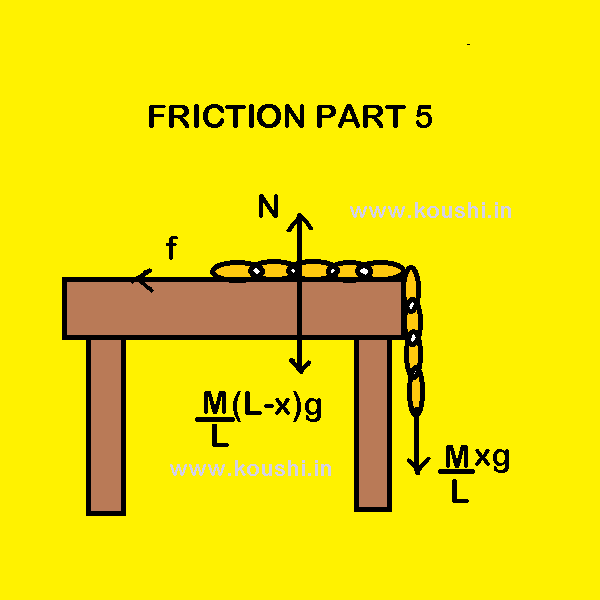Friction due to relative velocity: A block A of mass M is placed on horizontal table. Another block B of mass m is places on block A as shown in figure. Now v1 and v2 (v1 < v2) are the velocities of A and B respectively. The conditions are explained below.1.
The coefficient of static friction between A and B is ![]() . There is no friction in between block A and table. As v1 < v2, relative motion of A is towards left and relative motion of B is towards right.
. There is no friction in between block A and table. As v1 < v2, relative motion of A is towards left and relative motion of B is towards right.
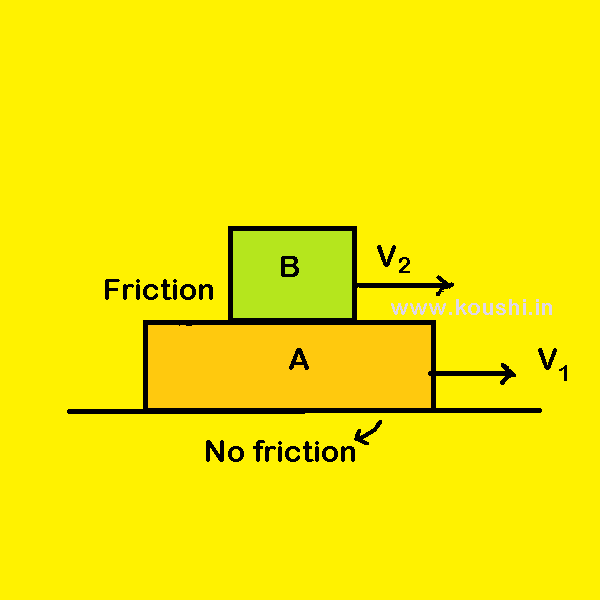
Therefore, limiting friction acts on A and B in the opposite direction of relative motion. The friction on A is in the direction of v1. So, it increases the speed of A. The friction on B is in the opposite direction of v2. So, it decreases the speed of B. So, after some time the speed of A and B remain same.
The friction between A and B is f = ![]() mg. The acceleration of A is aA =
mg. The acceleration of A is aA = ![]() =
= ![]() .
.
The acceleration of B is aB = ![]() =
= ![]() g.
g.
If t is the time after which two bodies move with same speed, then vA = vB
Or, v1 + aAt = v2 – aBt
Or, v1 + ![]() = v2 –
= v2 – ![]() gt
gt
Or, ![]() +
+ ![]() gt = v2 – v1
gt = v2 – v1
t = ![]() .
.
2. The common velocity is v = v1 + aAt = v1 + (![]() )(
)(![]() ) = v1 +
) = v1 + ![]() =
= ![]() =
= ![]() .
.
3. The displacement of A and B for the time when gaining that common speed is sA and sB respectively.
Therefore, sA = v1t + ![]() and sB = v2t –
and sB = v2t – ![]() .
.
Click the button to get the video explanation of this part.
A rod of length l weight w rests with end A on rough vertical wall and end B is on rough horizontal surface. The coefficient of friction between rod and wall is ![]() and coefficient of friction between rod and ground is
and coefficient of friction between rod and ground is ![]() . If the rod is in equilibrium, then find the minimum value of
. If the rod is in equilibrium, then find the minimum value of ![]() for which the rod tends to slide on ground.
for which the rod tends to slide on ground.
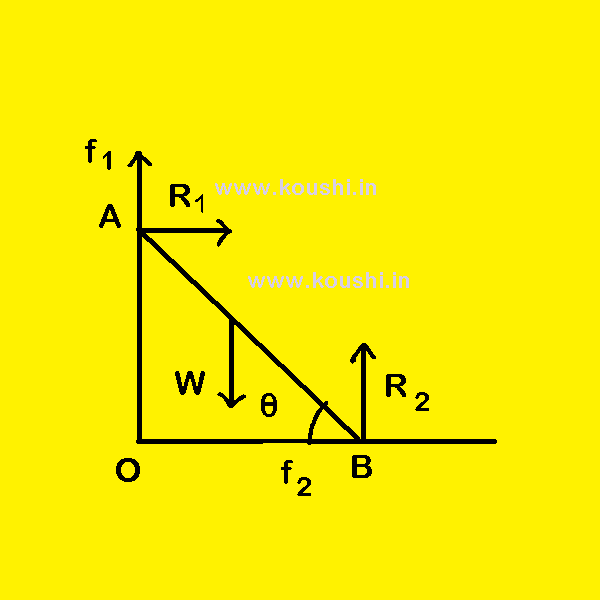
Let us consider the reaction forces act on the rod at point A and B are R1 and R2 respectively. The frictional force act at point A and B is f1 = ![]() R1 and f2 =
R1 and f2 = ![]() R2 respectively.
R2 respectively.
As the rod is in equilibrium then, R1 = f2 = ![]() R2 [
R2 [![]()
![]() = 0] ——- (i)
= 0] ——- (i)
And f1 + R2 = w or, ![]() R1 + R2 = w [
R1 + R2 = w [![]()
![]() = 0] ——- (ii)
= 0] ——- (ii)
For the rotational equilibrium of the rod, torque is zero. So, taking toque about point B we get,
– R1.BC – f1.BO + w.BE = 0
Or, w.BDcos![]() = R1BAsin
= R1BAsin![]() + f1BAcos
+ f1BAcos![]()
Or, wlcos![]() = R12lsin
= R12lsin![]() + f12lcos
+ f12lcos![]()
Or, 2R1sin![]() = cos
= cos![]() (w – 2f1)
(w – 2f1)
Or, tan![]() =
= ![]()
Or, tan![]() =
= ![]() [using equation (ii)]
[using equation (ii)]
Or, tan![]() =
= ![]()
Or, tan![]() =
= ![]() [using equation (i)]
[using equation (i)]
Or, tan![]() =
= ![]()
![]()
![]() =
= ![]() .
.
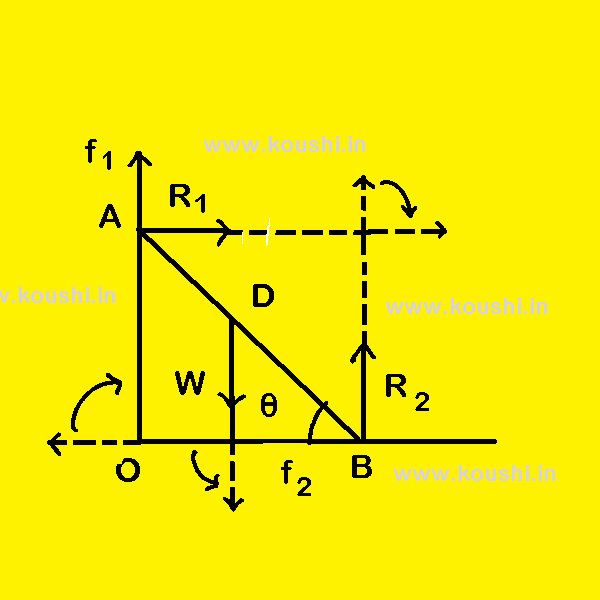
Click the button to get the video explanation of this part.
The length and mass of a chain is L and M respectively. If ![]() part of the chain is hanged from a rough table then the remaining part tends to side from the table. If the chain is released when half part is hanging from the table, then calculate the speed of the end of the chain during leaves the table.
part of the chain is hanged from a rough table then the remaining part tends to side from the table. If the chain is released when half part is hanging from the table, then calculate the speed of the end of the chain during leaves the table.
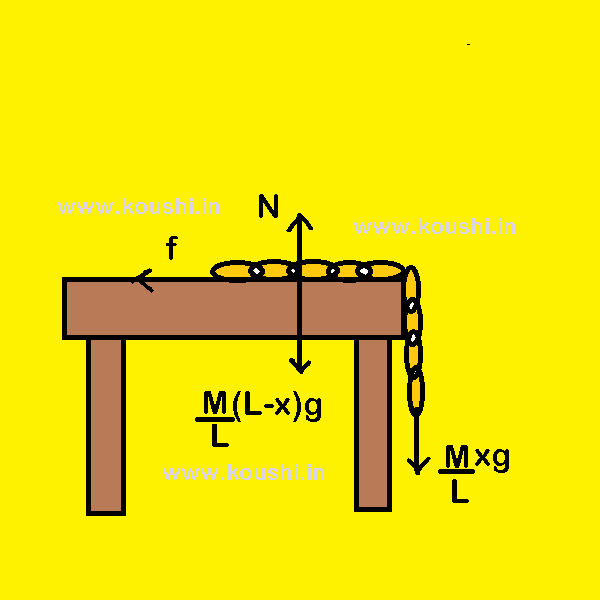
If the coefficient of friction between the table and chain is ![]() , then friction between the table and chain = weight of the hanging part
, then friction between the table and chain = weight of the hanging part
Or, ![]() =
= ![]()
![]()
![]() =
= ![]() .
.
Let us consider x (> ![]() part of the chain) is the length hanging from table. Then force acting on the chain is
part of the chain) is the length hanging from table. Then force acting on the chain is
F = ![]() –
– ![]() =
= ![]() –
– ![]() =
= ![]()
Acceleration of the chain a = ![]() =
= ![]() .
.
v![]() =
= ![]()
Or, vdv = (![]() )dx
)dx
Or, ![]() vdv =
vdv = ![]() (
(![]() )dx
)dx
Or, ![]() = [
= [![]() –
– ![]()
![]()
Or, ![]() =
= ![]()
Or, ![]() =
= ![]()
![]() v =
v = ![]() .
.
Click the button to get the video explanation of this part.
